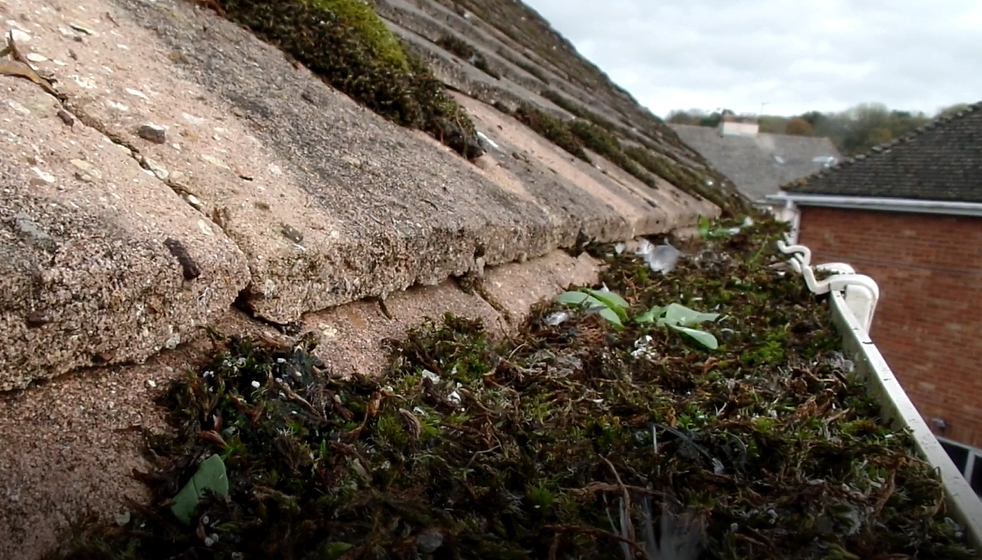Gutters
Examining gutters and downpipes
Background
The UK is a wet place as we all know! The Bristol area averages around 800-900 mm of rainfall a year, which is slightly above the UK average. Even more rain fell in recent years such as 2012 with weather conditions changing. Interestingly, in the past, South Bristol has been wetter than North Bristol.
So this rainwater must be diverted from your roof into your gutters, on its way to the drains. Gutters don’t just remove rainwater, they are an integral part of the house design and character!
They should prevent water from penetrating the tops of the walls and leaking gutters can often cause dampness problems. Furthermore, this is sometimes wrongly diagnosed as rising damp and a large inappropriate repair bill follows – although just replacing the gutters would have solved the problem.
Materials and Styles
Gutters have traditionally been made from many different materials. Historically, timber has often been used in the north of England, usually lined with lead. More common to Victorian era housing is cast iron and this is prone to rusting. In older properties, especially around South Bristol and Clifton, the gutters may be hidden behind parapet walls at the front of the property. Some Bristol properties have ‘butterfly’ roofs, where the gutters run in a valley hidden behind this parapet. Hence in such cases, inspection from ground level is impossible.
More recent gutters can be made from asbestos type cement, which therefore will be expensive to remove. Fortunately, you can carry out a simple check for asbestos gutters and pipework with a magnet; see our video https://youtu.be/tfihb5NdZRk . Recently, some gutters, especially long runs, have been made from extruded metal, usually aluminium, but the most popular material is UPVC – ‘plastic’ guttering.
What to look for?
Gutters
Now, you are looking for evidence of leakages and blockages.
Can you see any organic growth sprouting out of the gutters? That’s a sure sign that maintenance has been poor. Are there any overhanging trees whose leaves may have blocked the gutters in autumn?
Next, stand back from the building to check that the gutters are set to the correct falls. They should run in a straight horizontal line towards the downpipe with no dip or deviation.
Rainwater Goods Fastenings
Gutters should normally have supporting clips spaced at around 750 mm apart. Since the average man’s footstep is around 780 mm, you can pace the length of the gutter with an “average” man and there should be 1 clip per footstep. However, if sufficient clips are not present, the gutters can twist or bow or sag. When this happens, the correct fall is lost and they will start to leak as the weight of water causes pressure which damages the joints.
The joints between the lengths of gutter are usually located at the clips. Hence this is an easy place to look for heavily stained or soiled clips, suggesting leaks in these areas. And if a gutter has been leaking for a long time, stalactites may have formed on the underside of the gutter where water has been dripping. Another great giveaway is staining to the wall; this normally takes the form of darker streaks or patches or green algae or moss growth on the wall. Take note, because this will certainly indicate problems not only with the rainwater goods but potentially inside the property as well.
However,unless you can find a high level vantage point, you won’t be able to see inside the gutters; we use mast cameras as standard on our building surveys to check for blockages and detritus in the gutters.
Downpipes
Now look at the junctions connecting the gutter to the downpipe; these often incorporates an arrangement of curved sections. These joints are not normally supported by clips and are vulnerable to movement hence they are always susceptible to leakage. Again, this is a very common fault so look for moss growth or staining around the joints.
The downpipes should have clips securing them every 1.8 m. Again the average man is around 175 cm in height so this is a good datum. Downpipes often become blocked with moss and other detritus. So give them a knock to see if they sound hollow; if a dull sound is heard, then they may be full of moss and need to be cleared out.
The modern UPVC extruded parts for guttering and downpipes are very cheap to buy and the largest cost with installation is normally the labour element. As a result extensive repairs to gutters are normally a bad idea! Simply replacing them and obtaining a longer life is usually a better use of your money.
Where does that water go?
Lastly, are there any water butts at the foot of the downpipes? If so, are they overflowing into the foundations of the property? Do the downpipes lead into drains or do they splash their contents over the ground beneath, encouraging dampness, especially around bay windows ? We deal with dampness in another section, but the condition and design of the rainwater goods can give you some valuable pointers!

